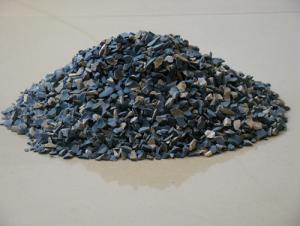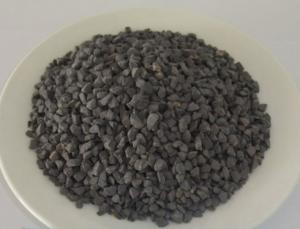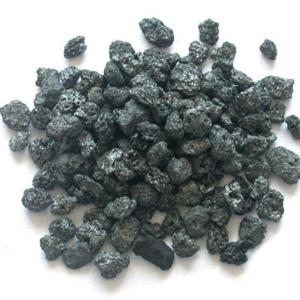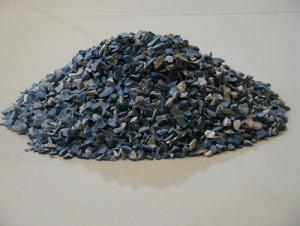Refractory Raw Materials-Carburant Materials
- Loading Port:
- Tianjin
- Payment Terms:
- TT OR LC
- Min Order Qty:
- 20 m.t.
- Supply Capability:
- 1000 m.t./month
OKorder Service Pledge
OKorder Financial Service
You Might Also Like
Bauxite is a naturally occurring, heterogeneous material composed primarily of one or more aluminum hydroxide minerals, plus various mixtures of silica, iron oxide, titania, aluminosilicate, and other impurities in minor or trace amounts.
Application
Aluminium is a product of increasing importance for manufacturing because of its light weight, strength and durability as well as its capacity to be recycled. On a life cycle assessment basis, the high strength to weight ratio of aluminium results in significant fuel savings, particularly where substitution can be made for heavier construction materials.
Features
With high aluminum
Low iron
Low silicon and low alkali content
- Q:What's the difference between refractory metal raceway and fireproof raceway?
- In terms of fire protection, fireproof raceway means that it is composed of the material with certain combustion performance and generally made of flame retardant or incombustible?material. While for the refractory raceway, according to GA 479-2004 "Fire Resistant Cable Tray", its most important properties are: Fire resistance of the cable tray should meet with the following requirements: The cable tray of I grade fire resistance should keep the working time more than 60min, of II grade fire resistance should keep the working time more than 45min, and of III grade fire resistance should keep the working time more than 30min. Hope this is helpful for you! Thank you.
- Q:What does the function of SiC for refractories?
- Anti-wear! High intensity!
- Q:What's the frequently used refractory material?
- Refractory material is generally used in industrial departments like metallurgy, glass, cement, ceramics, machinery, hot working, petrochemical industry, power and national defense. Frequently used common refractory: silica?brick, semi-silica brick, clay brick, high alumina brick, magnesia brick, etc. Frequently used special refractory: AZS brick, corundum brick, direct-bonded?magnesia-chrome?bricks, carborundum brick, calcium oxide, chromium hemitrioxide, alumina, magnesium oxide, etc. Frequently used fireclay insulating refractory: diatomite product, asbestos product, insulation?board, etc. Frequently used unshaped refractory: ramming refractory, refractory castable, plastic refractory, refractory mortar, gun-mix refractory, refractory coating, lightweight refractory?castables, etc.
- Q:Who knows the fire endurance of rock wool color plate?
- I'm glad to answer your question and offer you some of my experiences, for reference only. In fire?safety?rules, it can be divided into non-combustible component, hard-combustible component, combustible component according to the combustible degree of building materials. Rock wool board is building board recombinated artificially by fibers processed by coated steels and inorganic minerals like basalt mineral, because steel plate and rock wool which is the main components are non-combustible material, so rock wool board should be considered as non-combustible component. The fire endurance of rock wool board has its own judging criteria. Lose sustaining power, integrity and fire insulation function. Its fire endurance is within 2 hours.
- Q:Where is the development of refractory industry?
- Refractories for continuous casting is an important part of the continuous casting machine, in addition to the characteristics of general refractory material, also for the purification of molten steel and improve the steel quality, stable molten steel temperature and composition, control and regulate the flow of the molten steel and other functions, so it is called functional refractories.
- Q:Is the linear change on reheating the same as heating permanent linear change of refractory material?
- “+”represents expansion. the afterexpansion and aftercontraction after cooled to be at room temperature. The change may significantly damage the masonry of thermal kiln. There are regulations on the linear change on reheating of common refractory material in the national standard. Some physical chemical changes may continue. It is defined as the change from being heated to the specified temperature of refractory material sample. Heat preserving for a while till afte cooling to be at room temperature, then the residual will expand or contract in its length, heat preservation for a while, organization vitrification, the irreversible changes of its length refers to heating the firing refractory to be at high temperature, so as to make the volume of refractory materials expand or contract, due to the influence of uneven temperature or lack of time, otherwise it will cause the deformation of the refractory ball and make this indicator within standard even reach smaller value, so firing control must be strengthened in product production. But it is should not be too high. For refractory materials with same chemical composition, the linear change on reheating is produced in the heating process. Properly increasing sintering temperature and prolonging the holding time is an effective process measures, make its firing inadequate. When subjected to high temperature, it can reduce the thermal shock resistance. Minus sign "-" represents contraction. The permanent line rate refers to heating the fire refractory ball to the specified temperature. Linear change on reheating, also known as residual linear change, is an important indicator to assess the quality of refractory in the long time use. To control the permanent line rate within the standard or reach the minimum value.
- Q:How to choose refractory material
- Refractory fiber according to different raw materials, there are aluminum silicate, quartz, alumina and graphite, refractory fiber. Commonly used aluminosilicate refractory glass fiber is amorphous, including ordinary aluminum silicate fiber, high-purity aluminum silicate fiber, chromium silicate fiber, long-term use temperature of 1000-1200 degrees.
- Q:What refractories are accessible with ease in daily life?
- Refractory mortar. Thermal insulation refractory materials include diatomite products, refractory castables, monolithic?refractories, carborundum bricks, gun-mix refractories, semi-silica bricks, borides, beryllia, silicide, calcium oxide, high alumina refractory brick, refractory coatings, corundum bricks, fireclay?bricks, silicon nitride bonded silicon carbide bricks, chromium hemitrioxide and other refractories. What refractories can be found mostly in the market? Common refractories. Common refractories include silica bricks. The mostly used unshaped refractories include fettling, ramming refractories, castable refractories, plastic refractories, refractory clay, gun-mix refractory, sling refractories, refractory coatings, lightweight refractory castables, stemming etc. The mostly used insulating refractories include diatomite products, asbestos products, insulation panels, etc. The mostly used special refractories include AZS bricks.
- Q:How long usually will the A-level fireproof materials prevent the flame?
- A-level fireproof materials refer to the materials which are made of non-combustible materials, it is a different concept from fire resistance. non-combustible elements: Components are made of non-combustible materials. Non-combustible materials refer to materials that will not burst into flame, and burn as well as be carbonized when affected by fire and high temperature in the air. Fire resistance: Having a fire resistance test on any building components -----according to the standard time-temperature curve. This period starts from the time when affected by fire and ends up with losing the ability to support or to insulate fire or the integrity of the components. It can be expressed in hours.
- Q:How to use fireclay?
- Mix refractory cement (ie aluminate cement CA50) with some refractory aggregate (bauxite, slag from flint clay) and powder (ie, crushed aggregate). Add some water to the mixture and stir, and it can be used. The clinker can be refractory powder.
1. Manufacturer Overview |
|
|---|---|
| Location | |
| Year Established | |
| Annual Output Value | |
| Main Markets | |
| Company Certifications | |
2. Manufacturer Certificates |
|
|---|---|
| a) Certification Name | |
| Range | |
| Reference | |
| Validity Period | |
3. Manufacturer Capability |
|
|---|---|
| a)Trade Capacity | |
| Nearest Port | |
| Export Percentage | |
| No.of Employees in Trade Department | |
| Language Spoken: | |
| b)Factory Information | |
| Factory Size: | |
| No. of Production Lines | |
| Contract Manufacturing | |
| Product Price Range | |
Send your message to us
Refractory Raw Materials-Carburant Materials
- Loading Port:
- Tianjin
- Payment Terms:
- TT OR LC
- Min Order Qty:
- 20 m.t.
- Supply Capability:
- 1000 m.t./month
OKorder Service Pledge
OKorder Financial Service
Similar products
New products
Hot products
Hot Searches
Related keywords



























